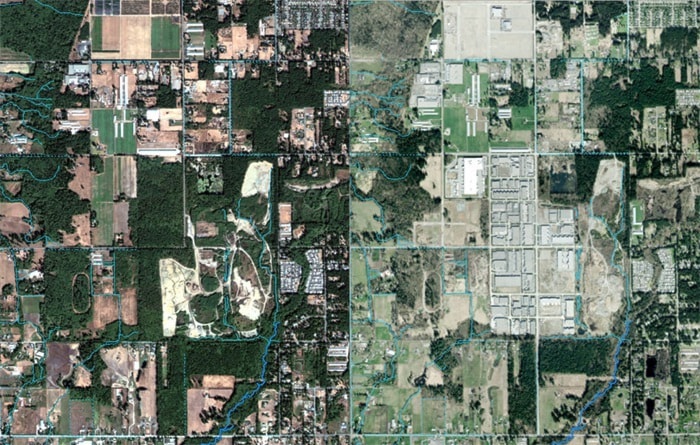Surrey has lost almost one-fifth of its tree canopy in just over a decade, according to a recent study commissioned by the city.
The report also shows stark differences between the amount of tree cover in existing developments to that which is provided in new construction.
The city hired North Surrey’s Urban Systems this year to provide an analysis of the city’s existing tree canopy.
A tree canopy (the above-ground portion of a tree) is a measure of plant cover in the city and is a major indicator of urban environmental health.
Research shows a canopy of 40 per cent is one aspect of being considered an environmentally friendly city.
Surrey is short of that and heading in the wrong direction.
In 2001, 33 per cent of Surrey was covered by trees, the report shows. By 2009, that dropped to 30 per cent, and four years later the figure had sunk to 27.17 per cent.
The numbers represent a decline in tree canopy of 17.66 per cent over those 13 years.
Surrey is aiming to be at 40 per cent by 2058, but it will require some significant changes to turn things around.
New developments are a large contributor to canopy loss, according to figures in the report.
The average existing single-family residential development (city-wide) in 2009 had 23.5-per-cent tree canopy. Now, the average new home construction has a 2.6-per-cent tree canopy.
The figure is even more stark in South Surrey, where it dropped from 47.8 per cent in 2009 to 7.7 per cent for new developments.
Similar drops occurred across the board when comparing existing developments to new ones.
“With current practices, the tree canopy will continue to decline and it could fall to somewhere between 21 per cent and 27 per cent over the next 50 years, depending on the development practices,” the report states.
The report indicates Surrey needs to set tree-canopy targets in each type of land use and fix decade-long targets with an aim to reach 40 per cent by 2058.
It also recommends updating existing bylaws to place more emphasis on tree canopy.
Private property owners should be given incentives to plant trees on their properties as well, the report states.
The city also needs to increase tree planting on city land and road allowances.
Panorama Ridge resident Bob Campbell called the findings of the study “deeply concerning.”
The report was presented to the Environmental Advisory Committee (EAC) on Wednesday night (Nov. 26).
Campbell, also the EAC vice-chair, said the committee needs to consult with other members of the community before presenting its opinion to Surrey council.
Mayor Dianne Watts said she wasn’t familiar with the findings of the study, but said it’s crucial that Surrey establish a baseline from which to build a greener city.
“We need that baseline so that we can reverse that (canopy loss),” Watts said Thursday, “which is actually a good thing, because we’re paying attention to it.”
She also said the challenge is to balance affordable housing with the environment.
“We need to be paying attention to the green infrastructure,” Watts said.
The EAC is expected to hear from the public as soon as its January meeting.
